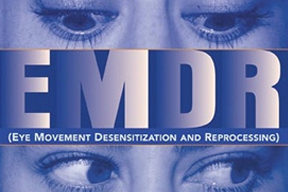Eye Movement Desensitization And Reprocessing (EMDR)
Eye movement desensitization reprocessing (EMDR) is a method of therapy developed by Francis Shapiro that was initially utilized for PTSD but now used in many different therapeutic situations. An explanation of the EMDR process as explained by Shapiro is a restoration of neural balance and reversal of neural pathology that takes place when saccadic movements are induced along with image and cognition of traumatic memory. This is based on Pavlov’s hypothesis that traumatic memories produce a pathological change in neural elements due to excitatory and inhibitory imbalances in the brain. The pathologic changes of neural elements prevent resolution of normal progression of information processing. The memory remains active in its original anxiety producing form. EMDR promotes the restoration.
There are eight structured phases to EMDR that helps the clinician; (1) get a detailed history and treatment plan, (2) prepare a therapeutic relationship with reasonable client expectations, prepare the client for active trauma processing, (3) assessments to identify target memories bases with validity of cognition scales (VOC) and subjective units of distress scales (SUDS), (4) desensitization phase using target images and eye movements,(5) installation phase of the positive validity of cognition, (6) body scan to assess for somatic response of the target, (7) closure if processing incomplete, and (8) re-evaluation for optimal treatment effects and to check for additional targets.
Areas EMDR is currently being used are; reduction of PTSD symptoms, sexual abuse and rape for better functioning, stress reduction, distress, anger, pain, depression, ADHD, dissociative disorders, self-esteem issues and personality pathology and spiritual development. This treatment is successfully used with adults, adolescents and children. With children mom and/or dad may be present and I often have the child sit on the parent’s lap while they process.

